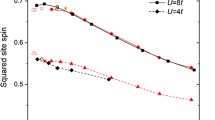Abstract:
We present a comparative study of the Hubbard and t - J models far away from half-filling. We show that, at such fillings the t - J Hamiltonian can be seen as an effective model of the repulsive Hubbard Hamiltonian over the whole range of correlation strength. Indeed, the | t/U| ∈0, + ∞ range of the Hubbard model can be mapped onto the finite range | J/t| ∈2, 0 of the t - J model, provided that the effective exchange parameter J is defined variationally as the local singlet-triplet excitation energy. In this picture the uncorrelated limit U = 0 is associated with the super-symmetric point J = - 2| t| and the infinitely correlated U = + ∞ limit with the usual J = 0 limit. A numerical comparison between the two models is presented using different macroscopic and microscopic properties such as energies, charge gaps and bond orders on a quarter-filled infinite chain. The usage of the t - J Hamiltonian in low-filled systems can therefore be a good alternative to the Hubbard model in large time-consuming calculations.
Similar content being viewed by others
Author information
Authors and Affiliations
Additional information
Received 22 February 2002 / Received in final form 6 May 2002 Published online 9 July 2002
Rights and permissions
About this article
Cite this article
Lepetit, MB., Doublet, ML. & Maurel, P. Similarities between the t-J and Hubbard models in weakly correlated regimes. Eur. Phys. J. B 28, 49–54 (2002). https://doi.org/10.1140/epjb/e2002-00198-5
Issue Date:
DOI: https://doi.org/10.1140/epjb/e2002-00198-5




